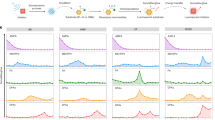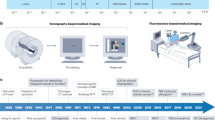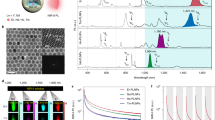Abstract
Optical imaging is crucial to study biological or pathological processes and diagnose diseases. However, poor tissue penetration typically limits conventional optical imaging. Here we report an imaging technique that uses ultrasound to activate luminescent molecules or nanoparticles through two-step intraparticle energy conversion. Ultrasonic activation can convert mechanical fluctuations into chemical energy via the piezoelectric effect and then induce luminescence via the chemiluminescent effect. We demonstrate two modalities for ultrasound-induced luminescence imaging: one achieves delayed imaging after cessation of the ultrasonic excitation, and the other enables real-time imaging during the ultrasonic excitation. Our imaging modality offers an improvement in luminescence intensity of up to 2,000-fold compared with sonoluminescence of H2O, a 10-fold improved of signal-to-noise ratio compared with fluorescence imaging, a spatial resolution of 1.46 mm and tissue penetration of up to 2.2 cm. We demonstrate its applicability for imaging subcutaneous and orthotopic tumours, mapping lymph nodes and screening peritoneal metastatic tumours. Furthermore, we design analyte-activatable luminescence probes based on resonance energy transfer, which can assess drug-induced hepatotoxicity and distinguish the responsivity of tumours after drug treatment. We expect that our technique will enable further preclinical and clinical applications, such as the study of histopathological lesions in living animals, the early detection of tumours, the profiling of biological molecules and the monitoring of cancer treatment or prognosis, among others.
This is a preview of subscription content, access via your institution
Access options
Access Nature and 54 other Nature Portfolio journals
Get Nature+, our best-value online-access subscription
$29.99 / 30 days
cancel any time
Subscribe to this journal
Receive 12 print issues and online access
$209.00 per year
only $17.42 per issue
Buy this article
- Purchase on Springer Link
- Instant access to full article PDF
Prices may be subject to local taxes which are calculated during checkout






Similar content being viewed by others
Data availability
All of the data that support the findings of this study are reported in the main text and Supplementary Information. The data that support the findings of this study are available from the corresponding author upon reasonable request, and data for all figures can be found at https://doi.org/10.6084/m9.figshare.24579853. Source data are provided with this paper.
References
Chen, Y.-S. et al. Ultra-high-frequency radio-frequency acoustic molecular imaging with saline nanodroplets in living subjects. Nat. Nanotechnol. 16, 717–724 (2021).
Jokerst, J. V. & Gambhir, S. S. Molecular imaging with theranostic nanoparticles. Acc. Chem. Res. 44, 1050–1060 (2011).
Klinkhammer, B. M. et al. Non-invasive molecular imaging of kidney diseases. Nat. Rev. Nephrol. 17, 688–703 (2021).
Lavine, K. J. & Liu, Y. The dynamic cardiac cellular landscape: visualization by molecular imaging. Nat. Rev. Cardiol. 19, 345–347 (2022).
Liu, J.-n, Bu, W. & Shi, J. Chemical design and synthesis of functionalized probes for imaging and treating tumor hypoxia. Chem. Rev. 117, 6160–6224 (2017).
Wang, Z. et al. Two-way magnetic resonance tuning and enhanced subtraction imaging for non-invasive and quantitative biological imaging. Nat. Nanotechnol. 15, 482–490 (2020).
Jiang, Y. & Pu, K. Molecular probes for autofluorescence-free optical imaging. Chem. Rev. 121, 13086–13131 (2021).
Zhao, Z. et al. Ultra-bright Raman dots for multiplexed optical imaging. Nat. Commun. 12, 1305 (2021).
Kim, E. H., Chin, G., Rong, G., Poskanzer, K. E. & Clark, H. A. Optical probes for neurobiological sensing and imaging. Acc. Chem. Res. 51, 1023–1032 (2018).
Li, Y., Gecevicius, M. & Qiu, J. Long persistent phosphors—from fundamentals to applications. Chem. Soc. Rev. 45, 2090–2136 (2016).
Weber, J., Beard, P. C. & Bohndiek, S. E. Contrast agents for molecular photoacoustic imaging. Nat. Methods 13, 639–650 (2016).
Pei, P. et al. X-ray-activated persistent luminescence nanomaterials for NIR-II imaging. Nat. Nanotechnol. 16, 1011–1018 (2021).
Pratt, E. C. et al. Prospective testing of clinical Cerenkov luminescence imaging against standard-of-care nuclear imaging for tumour location. Nat. Biomed. Eng. 6, 559–568 (2022).
Wu, X. et al. Tether-free photothermal deep-brain stimulation in freely behaving mice via wide-field illumination in the near-infrared-II window. Nat. Biomed. Eng. 6, 754–770 (2022).
Yang, M. et al. Chemiluminescence for bioimaging and therapeutics: recent advances and challenges. Chem. Soc. Rev. 49, 6800–6815 (2020).
Diao, S. et al. Fluorescence imaging in vivo at wavelengths beyond 1500 nm. Angew. Chem. Int. Ed. 54, 14758–14762 (2015).
He, S., Song, J., Qu, J. & Cheng, Z. Crucial breakthrough of second near-infrared biological window fluorophores: design and synthesis toward multimodal imaging and theranostics. Chem. Soc. Rev. 47, 4258–4278 (2018).
Miao, Q. et al. Molecular afterglow imaging with bright, biodegradable polymer nanoparticles. Nat. Biotechnol. 35, 1102–1110 (2017).
So, M.-K., Xu, C., Loening, A. M., Gambhir, S. S. & Rao, J. Self-illuminating quantum dot conjugates for in vivo imaging. Nat. Biotechnol. 24, 339–343 (2006).
Liu, H. et al. Intraoperative imaging of tumors using Cerenkov luminescence endoscopy: a feasibility experimental study. J. Nucl. Med. 53, 1579–1584 (2012).
Farhadi, A., Ho, G. H., Sawyer, D. P., Bourdeau, R. W. & Shapiro, M. G. Ultrasound imaging of gene expression in mammalian cells. Science 365, 1469–1475 (2019).
Gilad, A. A. & Shapiro, M. G. Molecular imaging in synthetic biology, and synthetic biology in molecular imaging. Mol. Imaging Biol. 19, 373–378 (2017).
Heiles, B., Terwiel, D. & Maresca, D. The advent of biomolecular ultrasound imaging. Neuroscience 474, 122–133 (2021).
Frenzel, H. & Schultes, H. Luminescenz im ultraschallbeschickten Wasser. Z. Phys. Chem. 27, 421–424 (1934).
Didenko, Y. T., McNamara III, W. B. & Suslick, K. S. Molecular emission from single-bubble sonoluminescence. Nature 407, 877–879 (2000).
Doktycz, S. J. & Suslick, K. S. Interparticle collisions driven by ultrasound. Science 247, 1067–1069 (1990).
Barber, B. P. & Putterman, S. J. Observation of synchronous picosecond sonoluminescence. Nature 352, 318–320 (1991).
Xing, D., He, L., Tang, Y. & Tan, S. Sonoluminescence imaging in vivo. In Proc. SPIE 4162, Controlling Tissue Optical Properties: Applications in Clinical Study (ed. Tuchin, V. V.) 86–92 (SPIE, 2000).
He, L., Xing, D., Yan, X. & Ueda, K.-I. Chemiluminescence detection from sonodynamic action in vitro and in vivo. In Proc. SPIE 4597, Biophotonics Instrumentation and Analysis (eds Chiou, A. E. T. et al.) 43–50 (SPIE, 2001).
He, L., Xing, D., Yao, Y., Yan, X. & Ueda, K.-I. Tumor detection with sonodynamic chemiluminescence from ATX-70 and FCLA under ultrasonic excitation. In Proc. SPIE 4612, Optical Methods for Tumor Treatment and Detection: Mechanisms and Techniques in Photodynamic Therapy XI (ed. Dougherty, T. J.) 196–203 (SPIE, 2002).
He, Y., Tang, Y., Tan, S. & Xing, D. FCLA-enhanced sonoluminescence imaging in vivo. In Proc. SPIE 3863, 1999 International Conference on Biomedical Optics (eds Luo, Q. et al.) 129–133 (SPIE, 1999).
He, Y., Xing, D., Tan, S., Tang, Y. & Ueda, K.-I. In vivo sonoluminescence imaging with the assistance of FCLA. Phys. Med. Biol. 47, 1535–1541 (2002).
Wang, L. V. & Shen, Q. Sonoluminescent tomography of strongly scattering media. Opt. Lett. 23, 561–563 (1998).
Xu, C. et al. Nanoparticles with ultrasound-induced afterglow luminescence for tumour-specific theranostics. Nat. Biomed. Eng. 7, 298–312 (2022).
Wang, W. et al. Ultrasound triggered organic mechanoluminescence materials. Adv. Drug Deliv. Rev. 186, 114343 (2022).
Wang, W. et al. Ultrasound-triggered in situ photon emission for noninvasive optogenetics. J. Am. Chem. Soc. 145, 1097–1107 (2023).
Wu, X. et al. Sono-optogenetics facilitated by a circulation-delivered rechargeable light source for minimally invasive optogenetics. Proc. Natl Acad. Sci. USA 116, 26332–26342 (2019).
Zhang, G. et al. A selective and sensitive chemiluminescence reaction of 4,4′(5′)-bis[2-(9-anthryloxy)ethylthio]tetrathiafulvalene with singlet oxygen. Chem. Commun., 2072–2073 (2004).
Dang, J. & Zhang, Q. Gas-phase reaction of benzo[a]anthracene with hydroxyl radical in the atmosphere: products, oxidation mechanism, and kinetics. J. Mol. Model. 24, 320 (2018).
Li, H. et al. Activity-based NIR fluorescent probes based on the versatile hemicyanine scaffold: design strategy, biomedical applications, and outlook. Chem. Soc. Rev. 51, 1795–1835 (2022).
Wu, X., Li, H., Lee, E. & Yoon, J. Sensors for in situ real-time fluorescence imaging of enzymes. Chem 6, 2893–2901 (2020).
Zhou, L., Zhang, P., Wang, H., Wang, D. & Li, Y. Smart nanosized drug delivery systems inducing immunogenic cell death for combination with cancer immunotherapy. Acc. Chem. Res. 53, 1761–1772 (2020).
Nguyen, A. et al. Granzyme B nanoreporter for early monitoring of tumor response to immunotherapy. Sci. Adv. 6, eabc2777 (2020).
Larimer, B. M. et al. Granzyme B PET imaging as a predictive biomarker of immunotherapy response. Cancer Res. 77, 2318–2327 (2017).
He, S., Li, J., Lyu, Y., Huang, J. & Pu, K. Near-infrared fluorescent macromolecular reporters for real-time imaging and urinalysis of cancer immunotherapy. J. Am. Chem. Soc. 142, 7075–7082 (2020).
Ngwa, W. et al. Using immunotherapy to boost the abscopal effect. Nat. Rev. Cancer 18, 313–322 (2018).
Zhao, Y. et al. ICAM-1 orchestrates the abscopal effect of tumor radiotherapy. Proc. Natl Acad. Sci. USA 118, e2010333118 (2021).
Acknowledgements
This work was supported by the National Key R&D Program of China (grant no. 2019YFA0210100 (to X.-B.Z.)) and the National Natural Science Foundation of China (grant nos U21A20287 (to G.S.) and 22234003 and 21890744 (to X.-B.Z.)).
Author information
Authors and Affiliations
Contributions
J.G. and Z.L. synthesized the TD molecules. S.X. and Y.F. synthesized the HBA-COOH molecules. Y.L. synthesized the BODIPY, BODIPY-Br and HD molecules. Z.L. and B.Y. synthesized the BTz-IC-H, BTz-IC-F and BTz-IC-Cl molecules. Y.W. and S.L. conducted all experiments in solution. Y.W., S.L. and Q.R. built all of the animal models and conducted all of the animal experiments. Y.W., Z.L. and S.L. synthesized all nanoparticles. Y.W. collected the raw data in all experiments and designed the schematic diagram. G.S. conceived the idea for this project. G.S. and Y.W. designed the research and all experiments. Y.W. and G.S. analysed all of the data and interpreted the results. Y.W., G.S., X.-B.Z. and W.T. wrote the paper. G.S., X.-B.Z., W.T. and Y.W. developed the discussion. G.S. supervised all experiments. Z.Y. and X.L. helped to analyse the luminescence mechanism and wrote the paper. All authors provided critical feedback on the research and the paper.
Corresponding authors
Ethics declarations
Competing interests
The authors declare no competing interests.
Peer review
Peer review information
Nature Photonics thanks Kanyi Pu and the other anonymous, reviewer(s) for their contribution to the peer review of this work.
Additional information
Publisher’s note Springer Nature remains neutral with regard to jurisdictional claims in published maps and institutional affiliations.
Extended data
Extended Data Fig. 1
Schematic diagram of set up apparatus for the mode of “delayed ultrasound-induced luminescence imaging” and “real-time ultrasound-induced luminescence imaging”.
Extended Data Fig. 2 Design of composite nanoparticles to enhance ultrasound-induced luminescence, in the mode of “delayed ultrasound-induced luminescence imaging”.
a, Schematic diagram for design of composite nanoparticles by luminescent molecule (PFODBT) and chemiluminescent substrates. b, TEM image revealed spherical PFODBT@HBA-NPs. c, Ultrasound-induced luminescence intensity of various chemiluminescent substrates doped PFODBT-NPs (50 μg mL–1, 400 µL) pre-excited with ultrasound (30 kHz, 4.5 W cm–2) for 45 s. d, Ultrasound-induced luminescence intensity of PFODBT@HBA-NPs with different ratios of HBA-COOH: PFODBT, nanoparticle solutions (50 μg/mL, 200 µL) were pre-excited with ultrasound (30 kHz, 4.5 W/cm2) for 15 s. e, Ultrasound-induced luminescence intensity of PFODBT@HBA-NPs with different surfactants, those nanoparticles (50 μg mL–1, 400 μL) were pre-excited with ultrasound (30 kHz, 4.5 W cm–2) for 30 s. f, Ultrasound-induced luminescence emission of PFODBT@HBA-NPs (PFODBT: HBA-COOH = 1: 1, 25 μg mL–1, 200 µL) in different channels, pre-excited with ultrasound (30 kHz, 4.5 W cm–2) for 15 s. g, Ultrasound-induced luminescence intensity of PFODBT@HBA-NPs (6.25 μg mL–1, 200 µL) after different time of ultrasonic excitation (30 kHz, 4.5 W cm–2). h, Ultrasound-induced luminescence intensity of various concentrations of PFODBT@HBA-NPs pre-excited with ultrasound (30 kHz, 4.5 W cm–2) for 15 s. Data for d–g are presented as mean values ± s.d. (n = 3).
Extended Data Fig. 3 Mechanism for ultrasound-induced luminescence of PFODBT@HBA-NPs.
a, Ultrasound-induced luminescence intensity of HBA-COOH-NPs, PFODBT-NPs, PFODBT@HBA-NPs (50 μg mL–1, 400 µL), pre-excited with ultrasound (30 kHz, 4.5 W cm–2) for 45 s. Data are presented as mean values ± s.d. (n = 3). b, Luminescence intensity of PFODBT@HBA-NPs (12.5 μg mL–1, 100 µL) excited by heating at various temperatures (for example, 10, 20, and 40 oC) or ultrasonic excitation (30 kHz, 4.5 W cm–2 for 15 s). c, Temperatures of PFODBT@HBA-NPs after receiving different times of ultrasonic excitation (30 kHz, 6.5 W cm–2), as measured by an infrared thermal camera. d, Reproducible voltage output of PFODBT when the ultrasonic transducer (30 kHz) was turned on and off. e, ESR spectra of 1O2 generated from PFODBT-NPs (200 µg mL–1, 100 µL) and trapping by 4-oxo-2,2,6,6-tetramethylpiperidine (TEMP) (1 M, 100 µL) before or after ultrasonic excitation. f, ESR spectra of •OH generated from PFODBT-NPs (200 μg mL–1, 100 μL) and trapped by dimethyl-1-pyrroline N-oxide (DMPO) (1 M, 100 μL) in water before or after ultrasonic excitation. g, Schematic diagram of ultrasound-induced luminescence mechanism for PFODBT@HBA-NPs.
Supplementary information
Supplementary Information
Supplementary Tables 1 and 2, Methods, Results and discussion, and Figs. 1–58.
Source data
Source Data Fig. 1
Statistical source data.
Source Data Fig. 2
Statistical source data.
Source Data Fig. 3
Statistical source data.
Source Data Fig. 4
Statistical source data.
Source Data Fig. 5
Statistical source data.
Source Data Fig. 6
Statistical source data.
Source Data Extended Data Fig. 1
Statistical source data.
Source Data Extended Data Fig. 2
Statistical source data.
Rights and permissions
Springer Nature or its licensor (e.g. a society or other partner) holds exclusive rights to this article under a publishing agreement with the author(s) or other rightsholder(s); author self-archiving of the accepted manuscript version of this article is solely governed by the terms of such publishing agreement and applicable law.
About this article
Cite this article
Wang, Y., Yi, Z., Guo, J. et al. In vivo ultrasound-induced luminescence molecular imaging. Nat. Photon. 18, 334–343 (2024). https://doi.org/10.1038/s41566-024-01387-1
Received:
Accepted:
Published:
Issue Date:
DOI: https://doi.org/10.1038/s41566-024-01387-1
This article is cited by
-
Illuminating cancer with sonoafterglow
Nature Photonics (2024)



